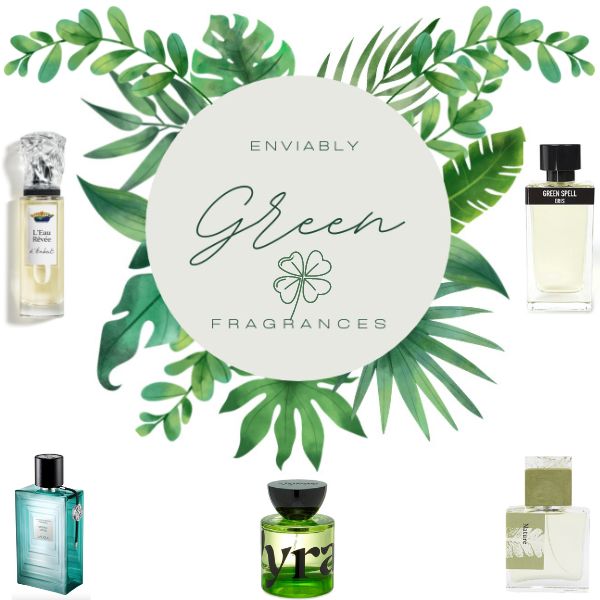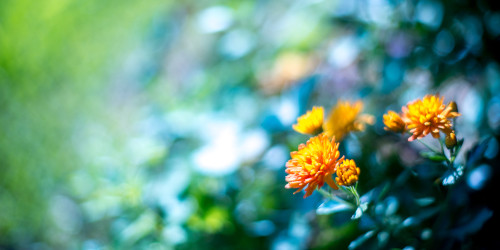Just when we thought the grey drizzle would be here forever, (just as we do every year around this time), suddenly there’s a green gasp of true spring in the air – a verdant pop of buds bursting, and a euphoria induced simply by looking at delicate, lime-coloured leaves unfurling.
Rather wonderfully, that new-leaf obsession is sometimes referred to as a ‘chlorophyll rush’, and it does almost feel as though we’re drugged with the joy of revival, so greedily do our eyes drink in the green, the newness of things, signs of life – of hope – re-emerging. In fragrances, green may be expressed as freshly-cut fleshy stalks in a florist’s shop, that insistent quickening of the blood in all living things as the sap rises.
As a colour, we have a peculiar relationship with green. As well as being the colour of spring, it can be classed as an unlucky colour that ‘belongs to the fairies’ and other mythological forest-dwellers, or the unsettling Pagan figure of ‘the green man’. It’s the ‘green-eyed monster’ of jealous rage, and the ‘green fairy’ of Absinthe addiction, too. Conversely, green can mean lucky – being associated with clover/shamrocks and St Patrick’s Day celebrations; or naïve, raw, young and inexperienced, and more recently, natural, organic – and indicating a belief in sustainable living.

As a smell, ‘green’ can brashly thrust or softly beckon, depending on the perfumer’s proclivities. The ultimate ‘green’ note in fragrance is called galbanum. It’s been used for centuries – millennia, actually, dating back to Biblical times, with the ancient Roman and Greeks burning galbanum-laden incense sticks, scenting their baths, adding to soothing skin balms, and also as a personal perfume.
Woody yet alive with the smell of clean, damp earth and the icily pure air of a mountain forest, galbanum essential oil is obtained via steam distillation of resin from the umbelliferous plant Ferula galbaniflua, native to Iran, Turkey and some neighbouring countries, and from a near-relative, Ferula gummosa. The plant looks a little like fennel and angelica, with a starburst of yellow flowers – but slice the stalk, and out oozes a milky juice, released by the plant to heal itself.
Other notes used to evoke this breath-of-fresh-air-through-an-open-window include green tea, grass, herbs, vines and leaves – violet leaf, for instance, provides an intriguing, almost mystical verdancy of woodland walks, while an accord representing tomato leaf is more astringent, slightly bitter, but evokes in many of us blissful childhood memories of greenhouses, and exploring a garden with all your senses. Geranium leaf, meanwhile, is lemony, quite potently fruity/herbaceous or even camphorously minty. Cassis (blackcurrant) is the distilled absolute of the blackcurrant buds and leaves, a.k.a. bourgeons de cassis (say it ‘boor-shon da cassee’): a light, fruity, woody note with a slightly animalic edge adored by those of us who appreciate its musky undertones – assiduously avoided by those who detest what they perceive as ‘tom cat’ notes in perfumes.
When cassis is used unapologetically stridently within a fragrance, and particularly when mosses and earthy patchouli are used to ground the composition; it can take on the more vintage air of a ‘green chypre’ – fragrances that are less Laura Ashley springtime picnic and more Wickerman meets Working Girl in nature. (I think if the music video for Radiohead’s song If You Say The Word were scented, it would be a wonderfully weird green chypre. Have a peek, above, if you’ve no idea what I’m talking about.)
Whichever shade of green scent you feel most drawn towards, I urge you to seek out some of my suggestions here, because they can freshen up your fragrance wardrobe and drag you by the collar out of the grey blah or blanketing wintery perfumes you’ve perhaps become accustomed to. Get some of that chlorophyl rush going with these…

SISLEY – L’EAU RÊVÉE D’HUBERT
An utterly sublime shot of cool, garden air to shake off the cobwebs. The geranium here is incredible quality, slightly minty, with a hint of rosiness (they call it ‘the male rose’ for its more textural, herbaceous furriness) and wrapped in savoury, peppery, grounding shiso leaf, papyrus and loamy patchouli.
£81 for 50ml eau de toilette harrods.com

VYRAO – I AM VERDANT
Sprouting forth greenery with every spritz, this sings of spring from the get-go, with cyclamen joyously bursting through the undergrowth, swags of moss-bedecked ivy draping the powdery comfort of iris, and bergamot bolstering the brightness of orange flower absolute. The kind of scent that just makes you beam.
£135 for 50ml eau de parfum selfridges.com
(Try a sample in the Vyrao High Five Set for £79)

LALIQUE LES COMPOSITIONS PARFUMÉES – IMPERIAL GREEN
Glorious greenery rendered luxurious, neroli is co-distilled here with ‘a secret molecule’ to amplify its fresh facets, while Ambroxan (the ‘secret’?) adds lengthening shadows in flower meadows. All anchored by grassy vetiver essence and the pared-back, almost aquatic green clarity of Patchouli Heart, it’s a grower.
£190 for 100ml eau de parfum lalique.com

CONTRADICTIONS IN ILK – NATURE
Imagine a city at sunrise, dew-speckled wildflowers shoving through cracks in walls and pavements, nature staking its claim via tangles of green ivy, sudden shocks of orange marigold, magnolia trees in private gardens, geraniums and nettles nestled on pathways, earth’s scent, keeping us (somewhat!) sane.
£165 for 50ml extrait de parfum SHOP
(Try a sample in the Contradictions in ILK Discovery Set for £48)

ERIS PARFUMS – GREEN SPELL
Living up to an ULTRA green promise, vibrant mandarin is squeezed over sharp blackcurrant absolute with Iranian galbanum and violet leaf absolute thrusting of snapped stalks and sap-drenched blooms. Tomato leaf shines with photorealistic phosphorescence, while narcissus and fig leaf nestle and nurture the base.
£115f or 50ml eau de parfum saintecellier.com
Written by Suzy Nightingale




